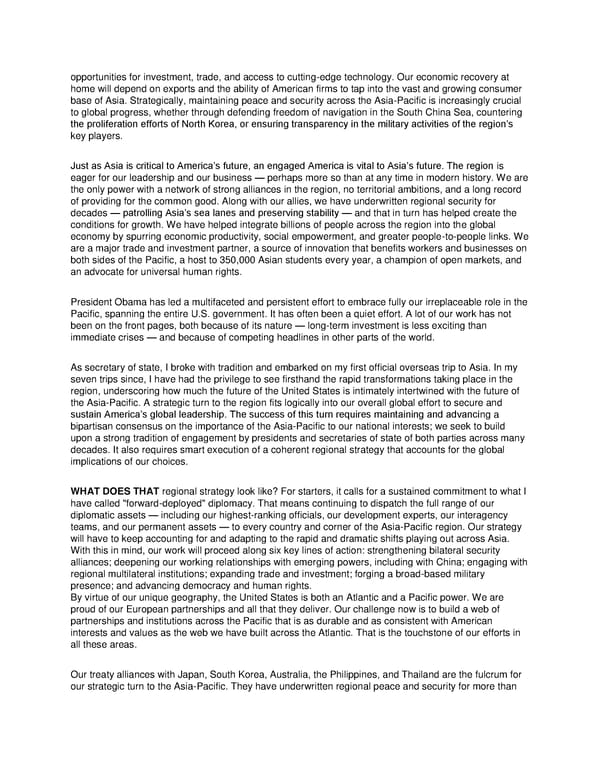opportunities for investment, trade, and access to cutting-edge technology. Our economic recovery at home will depend on exports and the ability of American firms to tap into the vast and growing consumer base of Asia. Strategically, maintaining peace and security across the Asia-Pacific is increasingly crucial to global progress, whether through defending freedom of navigation in the South China Sea, countering the proliferation efforts of North Korea, or ensuring transparency in the military activities of the region’s key players. Just as Asia is critical to America’s future, an engaged America is vital to Asia’s future. The region is eager for our leadership and our business — perhaps more so than at any time in modern history. We are the only power with a network of strong alliances in the region, no territorial ambitions, and a long record of providing for the common good. Along with our allies, we have underwritten regional security for decades — patrolling Asia’s sea lanes and preserving stability — and that in turn has helped create the conditions for growth. We have helped integrate billions of people across the region into the global economy by spurring economic productivity, social empowerment, and greater people-to-people links. We are a major trade and investment partner, a source of innovation that benefits workers and businesses on both sides of the Pacific, a host to 350,000 Asian students every year, a champion of open markets, and an advocate for universal human rights. President Obama has led a multifaceted and persistent effort to embrace fully our irreplaceable role in the Pacific, spanning the entire U.S. government. It has often been a quiet effort. A lot of our work has not been on the front pages, both because of its nature — long-term investment is less exciting than immediate crises — and because of competing headlines in other parts of the world. As secretary of state, I broke with tradition and embarked on my first official overseas trip to Asia. In my seven trips since, I have had the privilege to see firsthand the rapid transformations taking place in the region, underscoring how much the future of the United States is intimately intertwined with the future of the Asia-Pacific. A strategic turn to the region fits logically into our overall global effort to secure and sustain America’s global leadership. The success of this turn requires maintaining and advancing a bipartisan consensus on the importance of the Asia-Pacific to our national interests; we seek to build upon a strong tradition of engagement by presidents and secretaries of state of both parties across many decades. It also requires smart execution of a coherent regional strategy that accounts for the global implications of our choices. WHAT DOES THAT regional strategy look like? For starters, it calls for a sustained commitment to what I have called "forward-deployed" diplomacy. That means continuing to dispatch the full range of our diplomatic assets — including our highest-ranking officials, our development experts, our interagency teams, and our permanent assets — to every country and corner of the Asia-Pacific region. Our strategy will have to keep accounting for and adapting to the rapid and dramatic shifts playing out across Asia. With this in mind, our work will proceed along six key lines of action: strengthening bilateral security alliances; deepening our working relationships with emerging powers, including with China; engaging with regional multilateral institutions; expanding trade and investment; forging a broad-based military presence; and advancing democracy and human rights. By virtue of our unique geography, the United States is both an Atlantic and a Pacific power. We are proud of our European partnerships and all that they deliver. Our challenge now is to build a web of partnerships and institutions across the Pacific that is as durable and as consistent with American interests and values as the web we have built across the Atlantic. That is the touchstone of our efforts in all these areas. Our treaty alliances with Japan, South Korea, Australia, the Philippines, and Thailand are the fulcrum for our strategic turn to the Asia-Pacific. They have underwritten regional peace and security for more than
 HRC America's Pacific Century Page 1 Page 3
HRC America's Pacific Century Page 1 Page 3